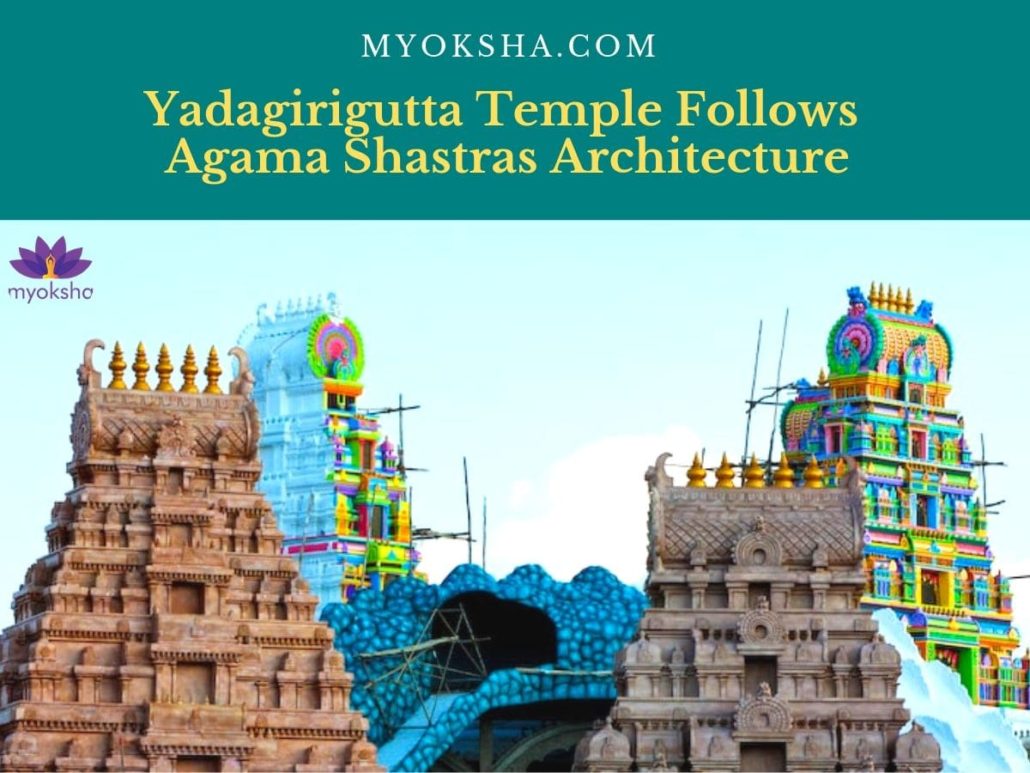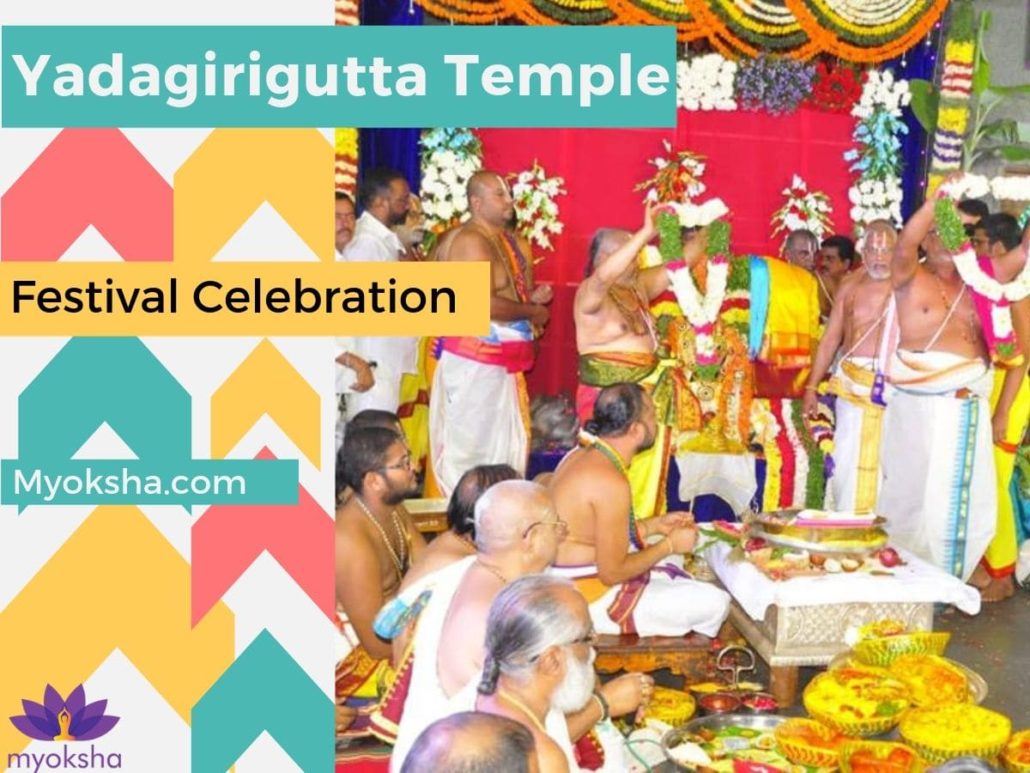Yadagirigutta, also known as Lakshmi Narasimha Temple or Yadadri Temple, is a Hindu temple situated in Nalgonda district, Telangana, India. The temple is dedicated to Sri Narasimha, an incarnation of Lord Vishnu. The number of pilgrims visiting this temple is very high since it is situated near the capital city.
The Official Website for Yadadgirigutta Temple is yadagirigutta.co.in.
Yadagirigutta Temple – Facts
| Deity | Lakshmi Narasimha, Lord Vishnu |
| Location | Nalgonda District, Telangana |
| Significance | Pancha Narasimha Varu |
| Entry Fee | Free |
| VIP Darshan | Rs. 150 per person |
| Darshan Timings | 4:00 AM to 9:30 PM |
| Poojas | Saswata Puja, Saswata Kalyanam, Abhisekam |
| Best Time to Visit | October to March |
| Visit Duration | 1 to 2 hours |
| Festivals | Brahmotsavam, Jayanti, Swathi Nakshatram |
Yadagirigutta Temple Timings
The temple opens at 4 AM and closes at 9:30 PM every day. However, there will be heavy crowds during Saturday, Sunday and other Public Holidays.
| Temple Opening Time | 4 am |
| After Noon Break | 3 pm to 4 pm |
| Temple Closing Time | 9:30 pm |

What are the Sevas and Poojas at Yadadri Temple?
The Aradhana and Pooja are performed in the temple according to Pancharatra Agama. Late Sri Vangeepuram Narasimhacharyulu who served as Sthanacharya of the temple sets the pooja procedure. The main Poojas are Saswata Puja, Saswata Kalyanam, Laksha Tulasi Puja, Abhisekam, etc.
| Morning Timings | |
| Suprabhatam | 4 AM to 4:30 AM |
| Binde Teertam | 4:30 AM to 5 AM |
| Bala Bogam | 5 AM to 5:30 AM |
| Nijabhishekam | 5:30 am to 6:30 AM |
| Archna | 6:30 AM to 7:15 AM |
| General Darshanam | 7:15 AM to 11:30 AM |
| Maharaja Bogamu | 11:30 AM to 12:30 Noon |
| Darshanams | 12:30 PM to 3 PM |
| Dwara Bandanamu | 03 PM to 04 PM |
| Evening Timings | |
| Special Darshnam | 4 PM to 5 PM |
| General Darshanam | 5 PM to 7 PM |
| Aaradhana | 7 PM to 7:30 PM |
| Archana | 7:30 PM to 8:15 PM |
| General Darshanam | 8:15 PM to 9 PM |
| Maha Nivedhana | 9 PM to 9:30 PM |
| Shayanostavam | 9:30 PM to 9:45 PM |
| Temple Close | 9:45 PM |
General Information for Pilgrims
- First devotees should pay a visit to Pancha Narasimha Varu before going for Yadagirigutta Temple.
- Deposit your offerings in the hundi only.
- Don’t perform Sastanga Pranama in the Antaralayam.
- Smoking, drinking and non-vegetarian food is strictly prohibited in the temple premises
- Don’t encourage beggars at Yadagirigutta.
- Don’t spit or throw garbage near the premises of the temple.
| Contact Office | Contact Number |
| Administration Office | 08685 – 236645 |
| Reception Office | 08685 – 236623 |
| Temple | 08685 – 236622 |
What is the significance of Yadagirigutta Temple?
- This is a very popular temple. It is said that the wishes of devotees visiting this temple will be fulfilled.
- The number of devotees visiting this temple is very high since it is situated near the capital city. On average, 5000-8000 pilgrims visit this temple daily.
- The pillars of 12 Alvars in the main temple is a significant feature of the temple.
- The silver idols of Lakshmi Narasimha inside the temple are also quite appealing to the pilgrims.

Nitya Annadanam Scheme
The Deavsthanam maintains Annadanam Scheme Since 1989. The donations received from the donors are being deposited and interest derived thereon is being spent towards Anna Prasadam Scheme. This scheme feeds 500 pilgrims daily on an average. However, the count increases to 1000 pilgrims daily on festival days like Bramhostavam and Karthika Purnima.
Donations can also be made for the construction of cottages & choultries for needy people. The Donation amount also comes under the category of Income Tax Exemption u/s 80G.
What are the miracles of Yadagirigutta Temple?
The miracle lies in a golden Sudarshana Chakra on the top of the Sanctum Sanctorum of this cave temple. The Chakra is the main weapon of Lord Vishnu and also the main symbol of the temple. The Chakra is also believed to posses mystic power and at times turns on its own. It is said that many years ago the chakra moved in a direction like a compass guiding the pilgrims towards the temple.
Also, as per the beliefs, Lord Narasimha has taken another 6th form of a doctor and is known as “Vaidya Narasimha” by his devotees. The Lord is known for curing many chronic diseases of its devotees.

What is the history of Yadagirigutta Temple?
According to the history, Maharishi Yada, son of the great sage Rishyasrunga and Santa Devi, performed penance here to Lord Vishnu. Being pleased with his devotion, Lord Narasimha (an incarnation of Lord Vishnu) appeared before him. He then manifested himself in five forms: Jwaalaa Narasimha, Gandabheranda Narasimha, Yogananda Narasimha, Ugra Narasimha, and Lakshmi Narasimha.
Maharishi Yada begged Sri Narasimha to stay on the hill in these forms. Lord Narasimha agreed to that and the hillock of Yadagirigutta became the abode of his all his five forms. All these five forms are presently worshipped inside the temple as Pancha Narasimha Kshetram.

What is the architecture of Yadagirigutta Temple?
The temple has followed the Thenkalai tradition of the Vaishnava Agama Shastras mostly observed in South India. The main architect of the temple was Anand Sai with lead architect P Madhusudhan. They were chosen for there understanding of ancient designs and Agama Shastras.
- The temple is built entirely in stone. Three types of stones are being used for the temple.
- Krishna Shila is used for presiding deities in the sanctum sanctorum.
- Stree Shila for idols of Goddesses.
- Napusaka Sila for flooring and walls.
- Black granite stone is also used similar to the temple architecture of the Kakatiya Dynasty in Telangana.
- The temple was earlier built on 2 acres but now the base for the temple is 14 acres.

New Yadadri Temple
A new Yadadri temple is being built at the old temple site. The temple is also renamed as Yadadri by Chinna Jeeyar Swamy. He is also overseeing and guiding the construction of the new temple. The entire temple project is expected to be completed by the end of 2019.
Donations and Renovations
The Chief Minister of Telangana, K. Chandrashekhar Rao approved the renovation of the temple with a budget of ₹1800 crores. The work started in 2016 and is being executed by Yadadri Temple Development Authority (YTDA). The temple also owned 39 kilos of gold and 1,753 tonnes of silver for lining of the gopurams and walls.

What is inside Yadagirigutta Temple?
Yadadgirigutta temple is present in a cave that is 12 feet high and 30 feet long. The sanctum sanctorum or Garbhagriha is located inside the cave beside a huge rock. The temple entrance arch also represents Mahabhuta (the five elements).
The temple also has Lord Narasimha in all the five forms embedded with stone in the main cave. Jwala Narasimha is in the shape of a serpent. Similarily, Yogananda Narasimha appears sitting for meditation in a Yoga posture.
How to reach Yadagirigutta Temple?
Yadadri Temple is situated 62 km from Hyderabad and is well connected by both rail and road. The temple has a moderate climate in all seasons.
- By Air – The nearest international airport is Rajiv Gandhi International Airport from the temple. Other domestic airports nearby are Begumpet Airport and Nadargul Airfield.
- By Train – The nearest railway station is Raigir (about 5 km) and Wangapalli (7 km). After getting off from the train, one can take an auto-rickshaw or tanga to the temple.
- By Road – APSRTC & TSRTC runs plenty of buses from Hyderabad to Yadadri. You will find buses almost every 30 minutes. TSRTC is also running Volvo A/c buses to Yadagiri. The current charge is Rs. 112 per adult and it takes around 1.5 hours to reach Yadagiri.
What are the festivals celebrated at Yadadri Temple?

- Bramhostavams – The festival of Sri Swamy Vari Brahmothsavam occurs in the month of Palgunam (usually in the month of February & March). During Brahmothsavam, cultural programs like Harikathas, Bhajans, Vocal recites, Upanyasams, and Bharatha Natyam are performed. Reputed artists and scholars come from different places on this day.
- Jayanthi Mahotsavams – The festival of Sri Swamy Vari Jayanthi Mahotsavam occur from the day of Vysakha Sudha Dwadasi till Chaturdashi. Various Parayanams like Ramayan, Maha Bharat, Bhagawath Geetha, Kshetra Mahathyam, etc are arranged at the time of Brahmothsavams and Jayanthi. The Peethadhipathis & Mathadhipathis also visits the temple
- Astothara Satha Ghatabhisekam – This will occur every month on Swathi Nakshatram (Birth star of Swamy Varu). The Pooja starts at 4:30 AM till 7:00 AM as per the Agama Shastra procedure.
- Pavithrostavams – Sri Swamy vari Pavithrotsavams starts from Shravana Shudha Dashami to Dwadashi.
- Adhyanotsavams – Sri Swamy vari Adhyayanotsavams starts six days from Vaikunta Ekadashi.
- Dhanurmasams – During these days, early morning a Margali will be held in the temple daily. Thiruppavai Keerthanams are also performed by Archakas.
- Annakutothsavam – Annakutostavam is performed on the day of Karthik Purnima.
Where to stay nearby?
The Devasthanam operates a number of choultries, dormitories, and cottages as an accommodation to the devotees. The rooms and halls are also AC & Non- AC and available both uphill and downhill. The room rent ranges from Rs. 50 to Rs. 200 for one day.
There is also sufficient water supply and security measures to safeguard the temple premises.
Tourist Attractions Nearby Yadagirigutta Temple
- Sri Patha Lakshmi Narasimha Swamy Temple – This temple is situated at a very nearest place called Pathagutta and is 2 km from the main temple. The deities here are also in the form of stone. The temple also has similar Kainkaryams & Uthsavams throughout the year.
- Surendrapuri – This famous Mythological Awareness Center is around 5 km from Yadagirigutta Temple. This museum was established to raise awareness of Indian mythology. It was established by Kunda Satyanarayana in memory of his son Surendra. It is also known locally as Kunda Satyanarayana Kala Dhama.
- Bhongir Fort – This ancient fort is situated in Nalgonda District, Bhuvanagiri, India. It is 9.8 km from Yadagirigutta Temple. Bhongir sits on a unique egg-shaped rock hill more than 500 feet high.
- Jain Temple – This temple is situated 22 km from Yadagirigutta. The temple is famous for Jain devotees. Jain devotees from all over India come here for the darshan of Sri Swethamber Jain Theerth.


